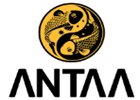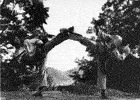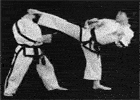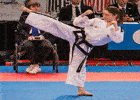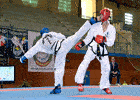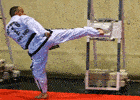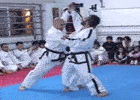Personal Training
At Parallax Taekwon-Do we offer the option of one to one private Taekwon-Do Instruction. This option is available to students that are currently training or for
students who would prefer not to, or are unable to attend classes.
Students that are currently training may require additional instruction to prepare for an upcoming grading or competitive event. New students may wish to receive private Instruction to help improve their fitness
or to learn Taekwon-Do in a more concentrated environment.
One to One Taekwon-Do Instruction consists of a series of warm up exercises, fitness training, stretching and pad drills. The sessions can be designed to suit your individual requirements or a training plan can be designed to give you an overall level of fitness and Taekwon-Do ability.
For the classes you will need to wear suitable clothing for exercise, and have a bottle of water to drink while training.
Through continued and dedicated training you can achieve the following benefits from training with Parallax Taekwon-Do.
- Increased flexibility
- Improved stamina
- Greater strength
- Improved body tone
- Better agility and reflexes
- Self-defence skills
Let Parallax Taekwon-Do help you to discover a new way to exercise.
If you have any questions, or if we can help you in any way, please do not hesitate to contact us.
Contact Details
Marc Fitzsimons
VI Degree
International Instructor & Examiner
0444 565 400
info@parallaxtkd.com.au
What Does Taekwon-Do Offer You?
Taekwon-Do can give you the ability and confidence to defend yourself powerfully and effectively. Whilst learning the various techniques you will
also be developing a high level of fitness, flexibility and self-discipline. Rarely does another martial art offer the same strong blend of intense
body conditioning and defensive skill development. Training in Taekwon-Do is very enjoyable and can bring with it a range of benefits:
Self-defence skills - You will learn basic and advanced offensive
and defensive skills which will increase your ability to defend yourself from attack by one or more opponents. Significant training time is spent on
defending against knives and other hand weapons, and against multiple opponents.
Moral code - Courtesy and respect toward others is an important part
of training. Mental and spiritual development goes hand-in-hand with physical training in Taekwon-Do.
Improved health & fitness - Taekwon-Do sessions
contain cardiovascular workouts, callisthenics, endurance training and all over strength development. This promotes weight loss, muscle development and suppleness.
Confidence and self discipline - Almost all people training in Taekwon-Do say that their
confidence has improved and that this positivity extends beyond training into other areas of their lives.
Social interaction - Getting the most from
Taekwon-Do is often about group spirit and teamworking with other students to develop your skills. Mutual encouragement and the intensity of training
makes for a friendly and positive class environment.
Taekwon-Do classes are generally 1-1:30 hours in duration. Special training classes and seminars may be longer. The classes are generally split
into 2 or 3 phases with the first phase almost always being a warm-up/fitness regime. Training may be pad-work, patterns, technical kicking, blocking,
weapon-defence, grappling, sparring and various other types of training to develop technique, accuracy, speed and power. Clothing should be loose-fitting
and stretchable - for example tracksuit bottoms and T-shirt - and no footwear is required.




